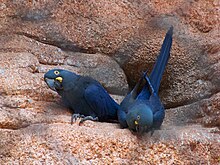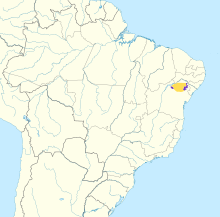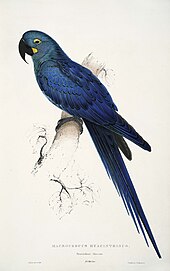
Macaws are a group of New World parrots that are long-tailed and often colorful. They are popular in aviculture or as companion parrots, although there are conservation concerns about several species in the wild.

The palm cockatoo, also known as the goliath cockatoo or great black cockatoo, is a large smoky-grey or black parrot of the cockatoo family native to New Guinea, Aru Islands, and Cape York Peninsula. It has a very large black beak and prominent red cheek patches.

Spix's macaw, also known as the little blue macaw, is a macaw species that was endemic to Brazil. It is a member of tribe Arini in the subfamily Arinae, part of the family Psittacidae. It was first described by German naturalist Georg Marcgrave, when he was working in the State of Pernambuco, Brazil in 1638 and it is named for German naturalist Johann Baptist von Spix, who collected a specimen in 1819 on the bank of the Rio São Francisco in northeast Bahia in Brazil. This bird has been completely extirpated from its natural range, and following a several-year survey, the IUCN officially declared it extinct in the wild in 2019. However, two batches of individuals have since been reintroduced into the wild in 2022.

Anodorhynchus is a genus of large blue macaws from open and semi-open habitats in central and eastern South America. It includes two extant species, the hyacinth macaw and Lear's macaw also known as the indigo macaw, and one probably extinct species, the glaucous macaw. At about 100 centimetres (39 in) in length the hyacinth macaw is the longest parrot in the world. Glaucous and Lear's macaws are exclusively cliff nesters; hyacinth macaws are mostly tree nesters. The three species mainly feed on the nuts from a few species of palms.
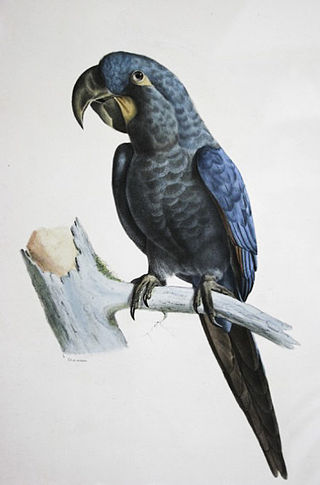
The glaucous macaw is a critically endangered or possibly extinct species of large, blue and grey South American parrot, a member of a large group of neotropical parrots known as macaws. This macaw is closely related to Lear's macaw and the hyacinth macaw. In Guaraní, it is called guaa-obi after its vocalizations.

The scarlet macaw is a large yellow, red and blue Neotropical parrot native to humid evergreen forests of the Americas. Its range extends from southeastern Mexico to Peru, Ecuador, Colombia, Bolivia, Venezuela and Brazil in lowlands of 500 m (1,600 ft) up to 1,000 m (3,300 ft), the Caribbean island of Trinidad, as well as the Pacific island of Coiba. Formerly, the northern extent of its range included southern Tamaulipas. In some areas, it has suffered local extinction because of habitat destruction, or capture for the parrot trade, but in other areas, it remains fairly common. It is the national bird of Honduras. Like its relative the blue-and-yellow macaw, the scarlet macaw is a popular bird in aviculture as a result of its striking plumage.

The red-and-green macaw, also known as the green-winged macaw, is a large, mostly-red macaw of the genus Ara.

The blue-and-yellow macaw, also known as the blue-and-gold macaw, is a large Neotropical parrot with a mostly blue dorsum, light yellow/orange venter, and gradient hues of green on top of its head. It is a member of the large group of neotropical parrots known as macaws. It inhabits forest, woodland and savannah of tropical Central and South America, as well as the island of Trinidad in the Caribbean. They are popular in aviculture because of their striking color, ability to talk, ready availability in the marketplace, and close bonding to humans.
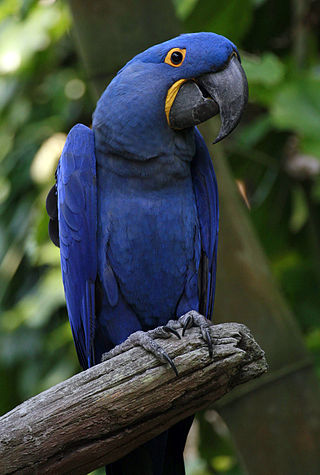
The hyacinth macaw, or hyacinthine macaw, is a parrot native to central and eastern South America. With a length of about one meter it is longer than any other species of parrot. It is the largest macaw and the largest flying parrot species; the flightless kākāpō of New Zealand outweighs it at up to 3.5 kg. While generally easily recognized, it could be confused with the smaller Lear's macaw. Habitat loss and the trapping of wild birds for the pet trade have taken a heavy toll on their population in the wild, so the species is classified as Vulnerable on the International Union for Conservation of Nature's Red List, and it is protected by its listing on Appendix I of the Convention on International Trade in Endangered Species of Wild Fauna and Flora (CITES).

The blue-throated macaw, also known as the Caninde macaw or Wagler's macaw, is a macaw endemic to a small area of north-central Bolivia, known as Los Llanos de Moxos. In 2014 this species was designated by law as a natural patrimony of Bolivia. Until 2010, it was hunted by native people to make feathered "Moxeño" headdresses for "machetero" ritual dances.

The red-bellied macaw, also known as Guacamaya Manilata, is a medium-sized, mostly green parrot, a member of a group of large Neotropical parrots known as macaws. It is the largest of what are commonly called "mini-macaws". The belly has a large maroon patch which gives the species its name.

The military macaw is a medium-sized macaw that gets its name from its predominantly green plumage resembling a military parade uniform. It is native to forests of Mexico and South America and though considered vulnerable in the wild, it is still commonly found in the pet trade industry.

The great green macaw, also known as Buffon's macaw or the great military macaw, is a critically endangered Central and South America parrot found in Nicaragua, Honduras, Costa Rica, Panama, Colombia and Ecuador. Two allopatric subspecies are recognized; the nominate subspecies, Ara ambiguus ssp. ambiguus, occurs from Honduras to Colombia, while Ara ambiguus ssp. guayaquilensis appears to be endemic to remnants of dry forests on the southern Pacific coast of Ecuador. The nominate subspecies lives in the canopy of wet tropical forests and in Costa Rica is usually associated with the almendro tree, Dipteryx oleifera.

The imperial amazon or Dominican amazon, also known as the sisserou or sisserou parrot, is a parrot found only on the Caribbean island of Dominica. It has been designated as the national bird of Dominica. The species is critically endangered. In 2019, it was estimated there were only about 50 mature individuals left in the wild.

The Cape parrot or Levaillant's parrot is a large, temperate forest dwelling parrot of the genus Poicephalus endemic to South Africa. It was formerly grouped as a subspecies along with the savanna-dwelling brown-necked parrot and grey-headed parrot, but is now considered a distinct species.

Syagrus coronata, commonly known as the ouricury palm, aricuri palm, or licuri palm, is a species of palm tree that is native to eastern Brazil, ranging from the southern part of the state of Pernambuco, into the state of Bahia, south to the Jequitinhonha River in the state of Minas Gerais. The tree can live for 30–150 years, though most only live for 8–10 years on average. It plays an important role in the diets of tropical seasonally dry forest animals.

The Guadeloupe amazon or Guadeloupe parrot is a hypothetical extinct species of parrot that is thought to have been endemic to the Lesser Antillean island region of Guadeloupe. Mentioned and described by 17th- and 18th-century writers, it received a scientific name in 1789. It was moved to the genus Amazona in 1905, and is thought to have been related to, or possibly the same as, the extant imperial amazon. A tibiotarsus and an ulna bone from the island of Marie-Galante may belong to the Guadeloupe amazon. In 1905, a species of extinct violet macaw was also claimed to have lived on Guadeloupe, but in 2015, it was suggested to have been based on a description of the Guadeloupe amazon.

A vulnerable species is a species which has been categorized by the International Union for Conservation of Nature as being threatened with extinction unless the circumstances that are threatening its survival and reproduction improve.

The Serra Branca / Raso da Catarina Environmental Protection Area is an environmental protection area in the state of Bahia, Brazil. Its sandstone cliffs are home to the endangered Lear's macaw.
